这里分为了两种情况:
E2E:接近真实使用情况,用例数量少
UT:执行速度快,用例数量多
1、整理测试点
1、注册功能
- 允许匿名访问
- URL:http://127.0.0.1:8000/accounts/register/
- get请求:返回html
- post请求:提交json参数,返回json响应
- 用户名不能为空
- 密码不能为空
- 两次密码必须相同
- 密码长度不能小于6
- 用户名不能重复
- 参数正确,则返回:注册成功
2、登录
- 允许匿名访问
- URL:http://127.0.0.1:8000/accounts/register/
- get请求:返回html
- post请求:提交表单,返回了重定向
- 用户名不能为空
- 密码不能为空
- 密码不能错误
3、提交反馈
- 不允许匿名访问
- URL:http://127.0.0.1:8000/lili/submit/
- GET:返回HTML
- POST::提交json,返回json- 提交的数据会入库- 提交的数据会和用户关联- 同一用户,不可重复发布
4、反馈的结果
- 允许匿名访问
- URL:http://127.0.0.1:8000/lili/result/
- 所有的请求返回:HTML
2、编写测试代码
主要学习两个部分的内容
1、django自带的测试组件
2、pytest-django插件
1、测试http请求
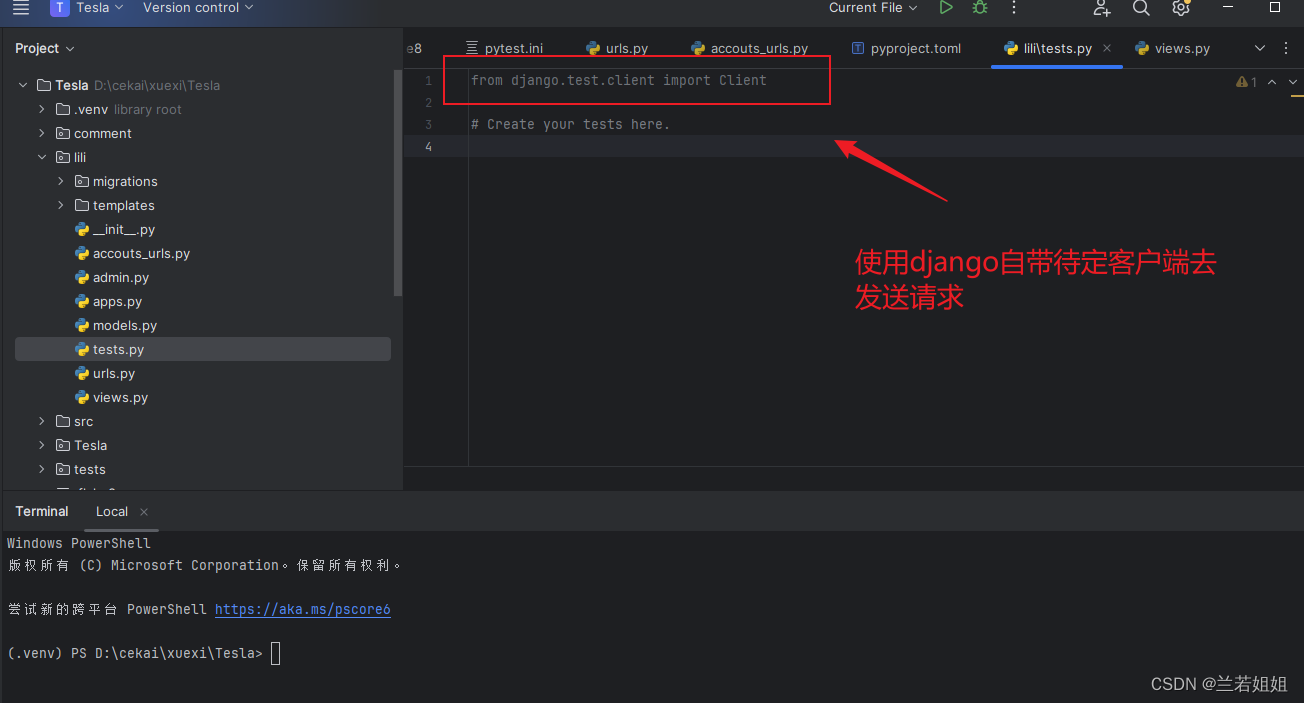
这个Client自己是一个客户端,同时也是一个服务端
import pytest
from django.http import HttpResponse
from django.test.client import Client
# Create your tests here.
@pytest.fixture
def client()->Client:
return Client()
def test_register(client:Client):
res:HttpResponse = client.get('/accounts/register/')
assert res.status_code ==200
html:str=res.content.decode('utf-8')
assert "账号" in html
assert "密码" in html
assert "确认密码" in html
执行:pytest
得到下面的结果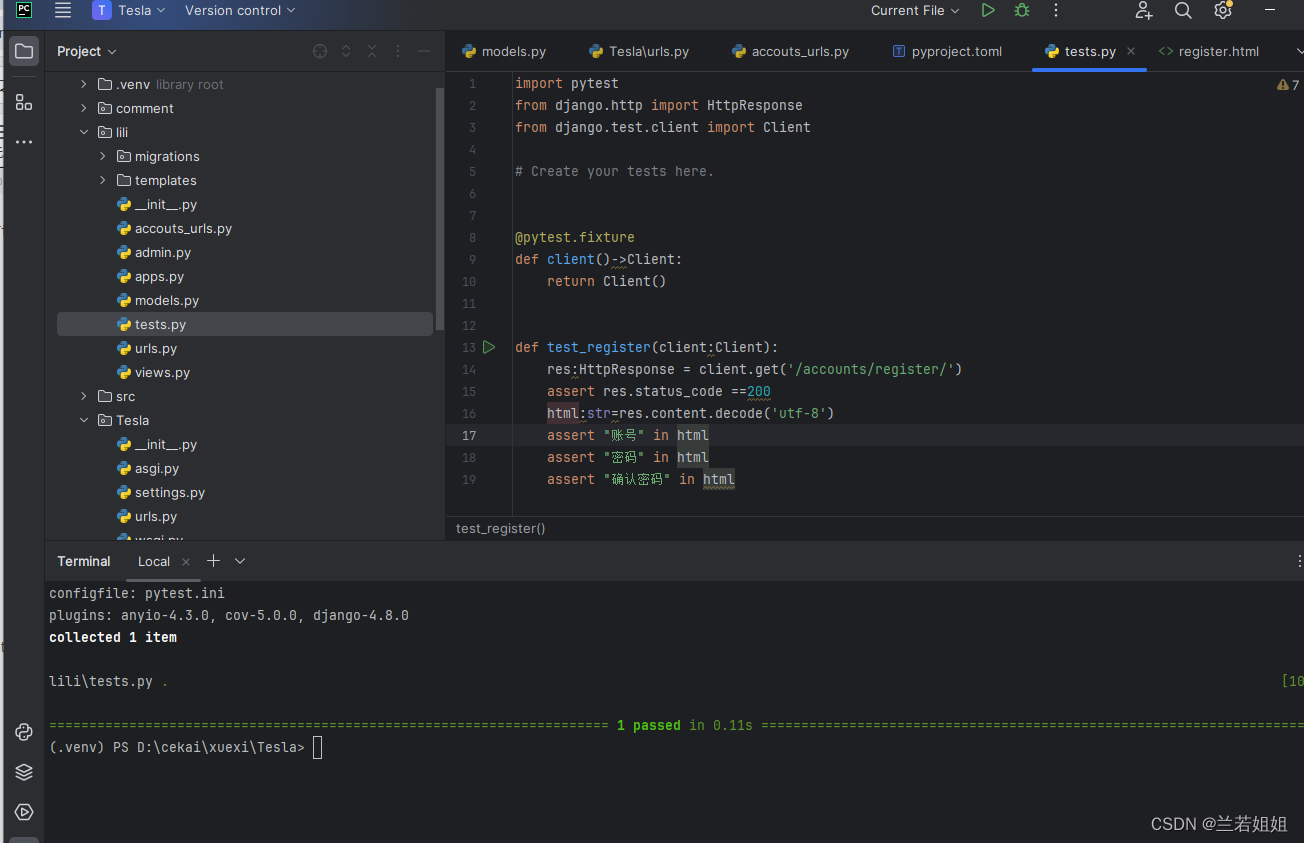
2、测试db数据库
import pytest
from django.contrib.auth.models import User
from django.http import HttpResponse
from django.test.client import Client
@pytest.fixture
def user(_django_db_helper):
new_user = User.objects.create_user(
username="lili01",
password="123456",
email="[email protected]"
)
"""这里是作为fixture的返回值,接下来创建测试用例"""
return new_user
def test_user(user):
"""这样每个都需要加"""
pass
其中_django_db_helper目的是为了进行数据准备,比如说在数据库中创建数据
import json
import pytest
from django.contrib.auth.models import User
from django.http import HttpResponse
from django.test.client import Client
from lili.models import Feedback
# Create your tests here.
@pytest.fixture
def client()->Client:
return Client()
def test_register(client:Client):
res:HttpResponse = client.get('/accounts/register/')
assert res.status_code ==200
html:str=res.content.decode('utf-8')
assert "账号" in html
assert "密码" in html
assert "确认密码" in html
@pytest.fixture
def user(_django_db_helper):
new_user = User.objects.create_user(
username="lili01",
password="123456",
email="[email protected]"
)
"""这里是作为fixture的返回值,接下来创建测试用例"""
return new_user
@pytest.mark.parametrize("data,code,message",[
({"username":"lili02",
"password":"",
"password_confirm":"123456",
"email":"[email protected]"
},-1,"password不能为空"),
({"username":"lili02",
"password":"1234567",
"password_confirm":"123456",
"email":"[email protected]"
},-2,"两次密码必须相同"),
({"username":"lili02",
"password":"12345",
"password_confirm":"12345",
"email":"[email protected]"
},-3,"密码长度必须大于等于6"),
({"username":"lili01",
"password":"123456",
"password_confirm":"123456",
"email":"[email protected]"
},-4,"用户已经存在,请重新注册"),
])
def test_register_post(user, client:Client,data,code,message):
"""这样每个都需要加"""
res:HttpResponse = client.post('/accounts/register/',data=data,content_type='application/json')
html = res.content.decode('utf-8')
res_json = json.loads(html)
assert res_json['code'] == code
assert res_json['message'] == message
除此以外,我们也可以对数据库进行断言,比如断言用户等于1
@pytest.mark.parametrize("data,code,message", [
({"username": "lili02",
"password": "",
"password_confirm": "123456",
"email": "[email protected]"
}, -1, "password不能为空"),
({"username": "lili02",
"password": "1234567",
"password_confirm": "123456",
"email": "[email protected]"
}, -2, "两次密码必须相同"),
({"username": "lili02",
"password": "12345",
"password_confirm": "12345",
"email": "[email protected]"
}, -3, "密码长度必须大于等于6"),
({"username": "lili01",
"password": "123456",
"password_confirm": "123456",
"email": "[email protected]"
}, -4, "用户已经存在,请重新注册"),
])
def test_register_post(user, client: Client, data, code, message):
# 断言用户等于1,
user_list = list(User.objects.all())
user_list_len = len(user_list)
assert user_list_len == 1
"""这样每个都需要加"""
res: HttpResponse = client.post('/accounts/register/', data=data, content_type='application/json')
html = res.content.decode('utf-8')
res_json = json.loads(html)
assert res_json['code'] == code
assert res_json['message'] == message
if res_json['code'] == 0:
user_list = list(User.objects.all())
user_list_len = len(user_list)
assert user_list_len == 4
3、自动登录
在这之前我们先测试下匿名访问这个功能,大概的思路是访问的时候返回的code不等于200,我之前的文有提到这里他会进行重定向,然后状态会变成302
def test_submit_anonymous(client: Client):
res: HttpResponse = client.get('/lili/submit/')
assert res.status_code == 302
开始执行,不想执行之前的用例,只执行test_submit_anonymous,可以用下面这个命令,
pytest -k test_submit_anonymous
那这种情况是没有登录的状态,接下来就来到重点,那么登录之后的状态是什么样的呢?具体要怎么做呢?请接着往下看
首先,我们需要用到@pytest.fixture,代码如下
tests.py
import json
import pytest
from django.contrib.auth.models import User
from django.http import HttpResponse
from django.test.client import Client
from lili.models import Feedback
# Create your tests here.
@pytest.fixture
def client() -> Client:
return Client()
def test_register(client: Client):
res: HttpResponse = client.get('/accounts/register/')
assert res.status_code == 200
html: str = res.content.decode('utf-8')
assert "账号" in html
assert "密码" in html
assert "确认密码" in html
@pytest.fixture
def user(_django_db_helper):
new_user = User.objects.create_user(
username="lili01",
password="123456",
email="[email protected]"
)
"""这里是作为fixture的返回值,在数据库里面创建数据,接下来创建测试用例"""
return new_user
@pytest.fixture
def user_clien(client: Client,user):
client.force_login(user)
return client
@pytest.mark.parametrize("data,code,message", [
({"username": "lili02",
"password": "",
"password_confirm": "123456",
"email": "[email protected]"
}, -1, "password不能为空"),
({"username": "lili02",
"password": "1234567",
"password_confirm": "123456",
"email": "[email protected]"
}, -2, "两次密码必须相同"),
({"username": "lili02",
"password": "12345",
"password_confirm": "12345",
"email": "[email protected]"
}, -3, "密码长度必须大于等于6"),
({"username": "lili01",
"password": "123456",
"password_confirm": "123456",
"email": "[email protected]"
}, -4, "用户已经存在,请重新注册"),
])
def test_register_post(user, client: Client, data, code, message):
# 断言用户等于1,
user_list = list(User.objects.all())
user_list_len = len(user_list)
assert user_list_len == 1
"""这样每个都需要加"""
res: HttpResponse = client.post('/accounts/register/', data=data, content_type='application/json')
html = res.content.decode('utf-8')
res_json = json.loads(html)
assert res_json['code'] == code
assert res_json['message'] == message
if res_json['code'] == 0:
user_list = list(User.objects.all())
user_list_len = len(user_list)
assert user_list_len == 4
def test_submit_anonymous(client: Client):
res: HttpResponse = client.get('/lili/submit/')
"""没有登录会重定向到登录界面"""
assert res.status_code == 302
def test_submit_login(user_clien: Client):
res: HttpResponse = user_clien.get('/lili/submit/')
html: str = res.content.decode('utf-8')
assert "商品质量" in html
assert "客服态度" in html
assert res.status_code == 200

接下来result这个接口的测试,我们把所有的方法都涵盖进去:
代码就是
tests.py
import json
import pytest
from django.contrib.auth.models import User
from django.http import HttpResponse
from django.test.client import Client
from lili.models import Feedback
@pytest.mark.parametrize("methond",["get","post","delete","put"])deftest_result_all(client: Client,methond):
res: HttpResponse = client.generic(methond.upper(),'/lili/result/')
html:str= res.content.decode('utf-8')assert res.status_code ==200
然后控制台允许用例
pytest -k test_result_all
3、分析和统计测试覆盖率
在pytets.ini这个文件里面加入这么一行内容
addopts =--cov=lili
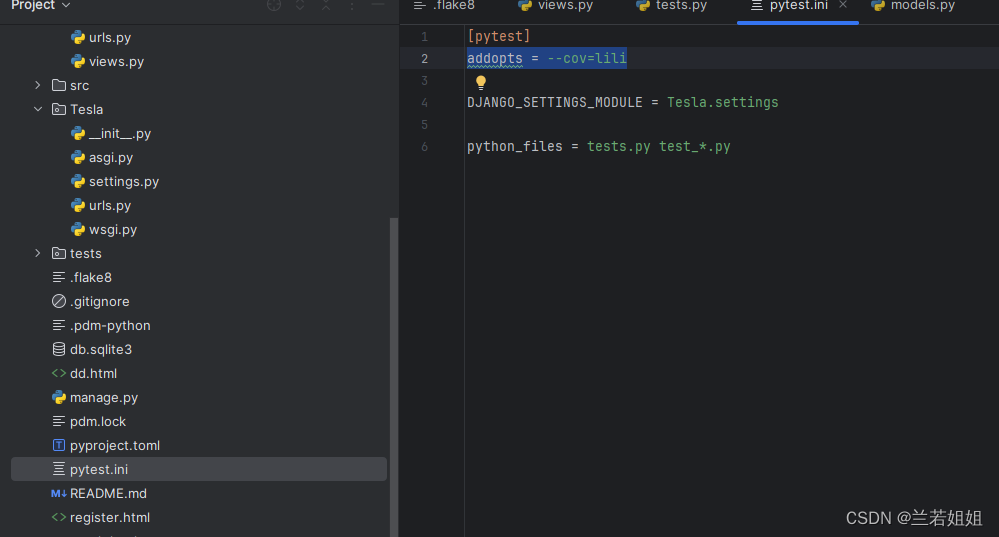
然后终端执行:pytest

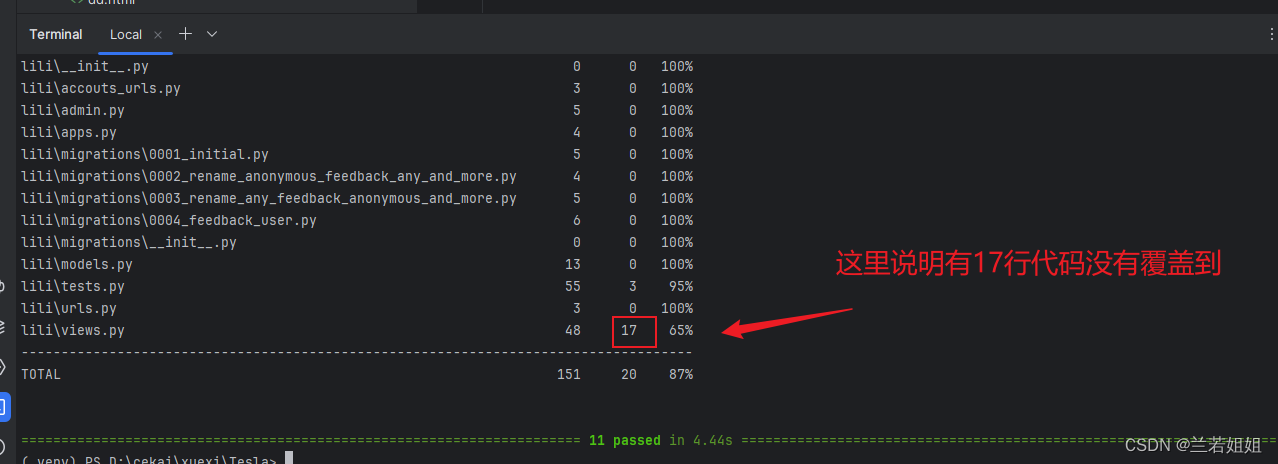
如何知道有哪17行代码没有覆盖到呢
继续修改pytets.ini这个文件里面加入这么一行内容
addopts =--cov=lili --cov-report html
然后运行:pytest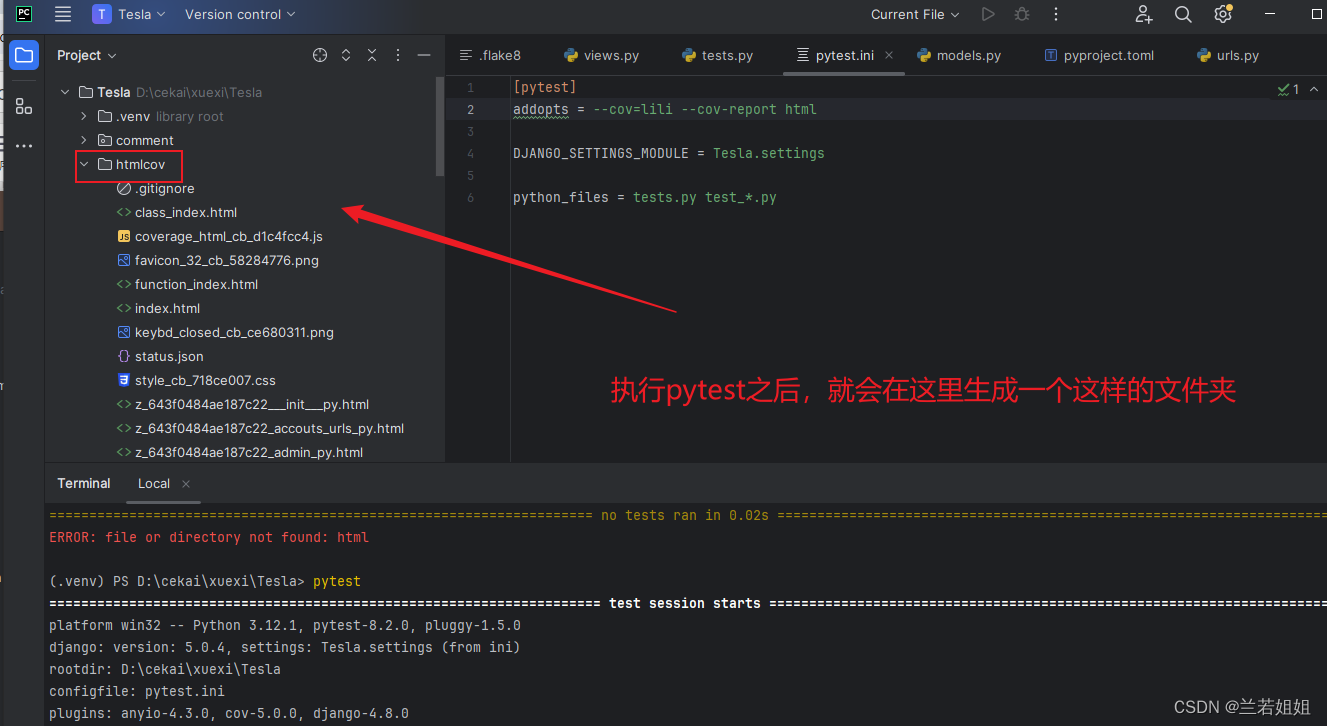
打开路径:D:\cekai\xuexi\Tesla\htmlcov\index.html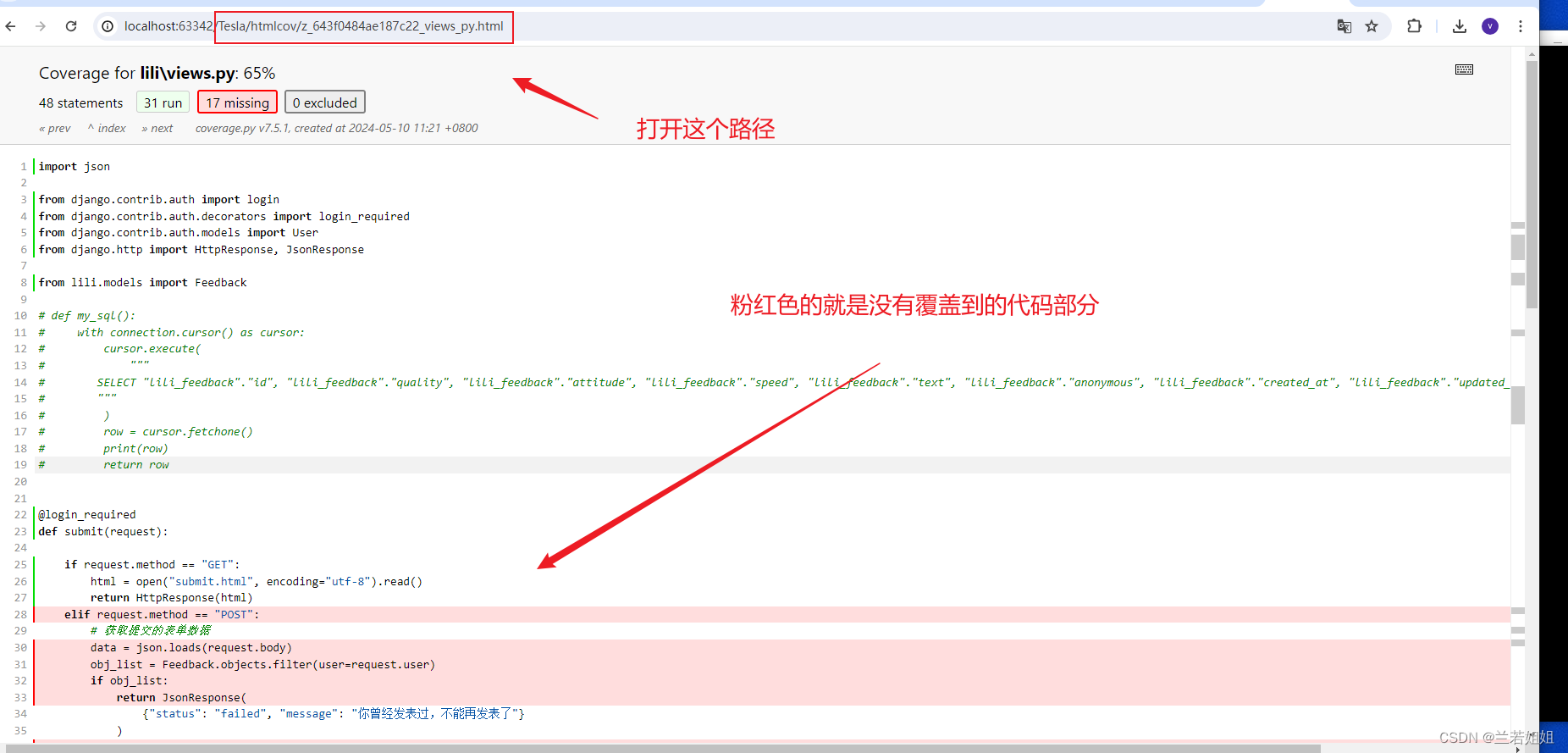
版权归原作者 兰若姐姐 所有, 如有侵权,请联系我们删除。